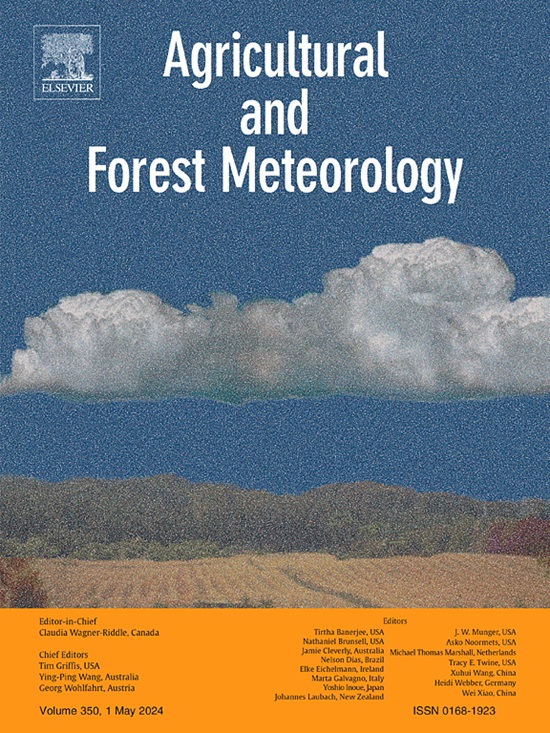Optimizing the closure period for improved accuracy of chamber-based greenhouse gas flux estimates
IF 5.6
1区 农林科学
Q1 AGRONOMY
引用次数: 0
Abstract
Non-steady-state chambers are often used for greenhouse gas flux measurements, and while there are recommendations on how long to keep the chamber closed, it is less investigated to what extent the length of the chamber closure period affects the estimated flux rates and which closure periods may provide the most accurate linear and non-linear flux estimates. Previous studies have shown that the closure of non-steady-state chambers induces a non-linear concentration development inside the chamber, even across short chamber closure periods, and that both linear and non-linear flux estimates are impacted by the chamber closure period itself. Based on 3,159 individual soil CO2 and CH4 flux measurements, we analyzed how linear regression and Hutchinson and Mosier (1981) modeled flux estimates are affected by the length of the chamber closure period by increasing it in increments of 30 sec, with a minimum and maximum chamber closure period of 60 and 300 sec, respectively. Across all detected flux measurements, the effect of chamber closure period length varied between 1.4–8.0 % for linear regression estimates and between 0.4–17.8 % for Hutchinson–Mosier estimates, and the largest effect sizes were observed in high flux regions. While both linear regression and Hutchinson–Mosier based estimates decreased as the chamber closure period increased, we observed a clear convergence of flux estimates as shorter and longer chamber closure periods were used for linear regression and Hutchinson–Mosier based estimation, respectively. This suggests using closure periods as short as possible for linear regression flux estimation or ensuring long-enough closure periods to observe a stabilization of Hutchinson–Mosier flux estimates over time. This analysis was based on soil flux measurements, but because the perturbation of the concentration gradient is related to the non-steady-state chamber technique rather than the measured ecosystem component, our results have implications for all flux measurements conducted with non-steady-state chambers.
优化封闭期,提高基于室的温室气体通量估算的准确性
非稳态室经常被用于温室气体通量测量,虽然有关于关闭多长时间的建议,但对关闭时间的长短在多大程度上影响通量估算率,以及哪些关闭时间可提供最准确的线性和非线性通量估算,研究较少。之前的研究表明,即使关闭时间较短,非稳态箱的关闭也会导致箱内浓度的非线性发展,而且线性和非线性通量估计值都会受到箱关闭时间本身的影响。基于 3,159 个单独的土壤二氧化碳和甲烷通量测量值,我们分析了线性回归和 Hutchinson 与 Mosier(1981 年)模型通量估算值如何受到试验室关闭时间长度的影响,试验室关闭时间以 30 秒为单位递增,最小和最大试验室关闭时间分别为 60 秒和 300 秒。在所有检测到的通量测量中,腔室关闭时间长度对线性回归估算值的影响在 1.4-8.0% 之间,对 Hutchinson-Mosier 估算值的影响在 0.4-17.8% 之间,在高通量区域观测到的影响最大。虽然线性回归和基于 Hutchinson-Mosier 的估算值都随着腔室关闭期的增加而减少,但我们观察到,当线性回归和基于 Hutchinson-Mosier 的估算值分别使用较短和较长的腔室关闭期时,通量估算值明显趋同。这表明在进行线性回归通量估算时,应尽量缩短封闭期,或确保足够长的封闭期,以便观察到 Hutchinson-Mosier 通量估算值随时间推移而趋于稳定。本分析以土壤通量测量为基础,但由于浓度梯度的扰动与非稳态室技术而非测量的生态系统成分有关,因此我们的结果对所有使用非稳态室进行的通量测量都有影响。
本文章由计算机程序翻译,如有差异,请以英文原文为准。
求助全文
约1分钟内获得全文
求助全文
来源期刊
CiteScore
10.30
自引率
9.70%
发文量
415
审稿时长
69 days
期刊介绍:
Agricultural and Forest Meteorology is an international journal for the publication of original articles and reviews on the inter-relationship between meteorology, agriculture, forestry, and natural ecosystems. Emphasis is on basic and applied scientific research relevant to practical problems in the field of plant and soil sciences, ecology and biogeochemistry as affected by weather as well as climate variability and change. Theoretical models should be tested against experimental data. Articles must appeal to an international audience. Special issues devoted to single topics are also published.
Typical topics include canopy micrometeorology (e.g. canopy radiation transfer, turbulence near the ground, evapotranspiration, energy balance, fluxes of trace gases), micrometeorological instrumentation (e.g., sensors for trace gases, flux measurement instruments, radiation measurement techniques), aerobiology (e.g. the dispersion of pollen, spores, insects and pesticides), biometeorology (e.g. the effect of weather and climate on plant distribution, crop yield, water-use efficiency, and plant phenology), forest-fire/weather interactions, and feedbacks from vegetation to weather and the climate system.

 求助内容:
求助内容: 应助结果提醒方式:
应助结果提醒方式:


